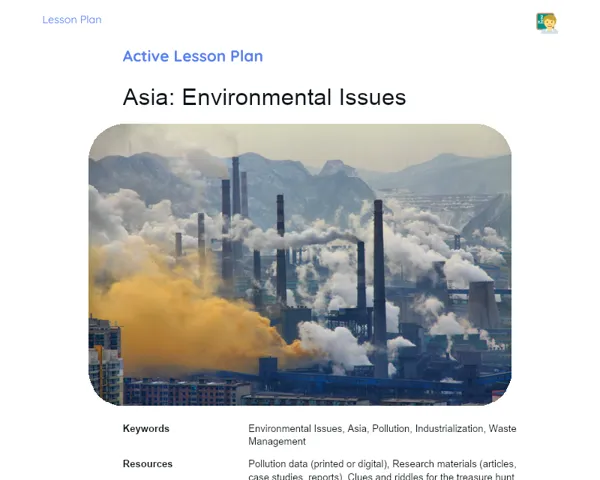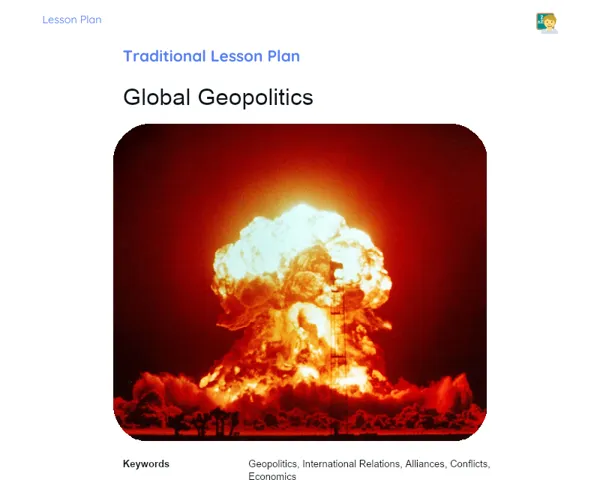Lesson Plan Teknis | Earth: Planet Formation
| Palavras Chave | Formation of the Earth, Layers of the Earth, Earth's Crust, Mantle, Core, Geology, Maker Activities, Three-Dimensional Models, Natural Resource Exploration, Teamwork, Critical Thinking, Practical Skills, Disaster Prediction |
| Materiais Necessários | Animation video of Earth's formation, Computer with projector, Foam, Clay, Play dough, Papier-mâché, Toothpicks, Markers, Paints, Brushes, Sheets of paper, Colored pencils |
Objective
Duration: (10 - 15 minutes)
This stage aims to introduce students to the topic of Earth's formation, underscoring the importance of comprehending its layers and components. Through engaging in practical activities, students will not only solidify their theoretical knowledge but also gain skills that are valuable in the job market, like model-making, teamwork, and collaborative problem-solving.
Objective Utama:
1. Introduce the various components that make up our planet Earth: the crust, mantle, and core (both outer and inner).
2. Develop practical skills through hands-on activities that involve constructing three-dimensional models of the Earth.
3. Encourage students to reflect on the significance of geological knowledge in today's job market.
Objective Sampingan:
- Stimulate teamwork and collaboration among students.
- Promote critical thinking by analyzing various materials and information sources about Earth's formation.
Introduction
Duration: (15 - 20 minutes)
This stage's aim is to familiarize students with Earth's formation, while highlighting the need for understanding its key layers and components. Through practical activities, students reinforce theoretical content and acquire important skills for the job market, such as model-making, teamwork, and collaborative problem-solving.
Curiosities and Market Connection
Did you know that studying Earth's layers is crucial for exploring natural resources like oil, natural gas, and minerals? Geologists and engineers rely on this knowledge to efficiently and sustainably locate and extract these resources. Moreover, understanding the dynamics of Earth's layers assists in predicting earthquakes and constructing safer buildings.
Contextualization
The formation of planet Earth is one of the most intriguing processes in science. Understanding how our planet came into existence and the layers that make it up helps us not only better understand geography and geology but also develop technologies and solutions for environmental and industrial challenges. From the crust we inhabit to the core that impacts Earth's magnetic field, each layer has its own significance and mysteries that draw scientists globally.
Initial Activity
To kick off the lesson, show a short video (3-5 minutes) featuring an animation of Earth's formation and its main layers. Then, pose this thought-provoking question: 'How do you think life on Earth would change if we didn’t have a solid crust?' This will help ignite students' curiosity about the topic.
Development
Duration: (50 - 60 minutes)
The aim of this stage is to deepen students' understanding of Earth's layers through a practical and interactive activity. This not only consolidates their theoretical knowledge but also develops relevant job-related skills such as model building, research, teamwork, and presentation skills.
Topics
1. Formation of the Earth
2. Layers of the Earth: Crust, Mantle, and Core (Inner and Outer)
3. The Significance of Earth's Layers in Geology and Industry
Thoughts on the Subject
Encourage students to think about how knowledge of Earth's layers might influence their lives and future career choices. Lead a discussion on practical applications of this knowledge, which can range from natural resource exploration to civil engineering and disaster preparedness.
Mini Challenge
Building Earth in Layers
Students will create a three-dimensional model of Earth's layers using accessible materials like foam, clay, play dough, or papier-mâché. This activity enhances practical understanding of the different layers of the planet and their distinct characteristics.
1. Divide students into groups of 4 to 5.
2. Provide necessary materials for each group: foam, clay, play dough, or papier-mâché, toothpicks, markers, and paints.
3. Explain that each group should create a model of the Earth, showcasing the crust, mantle, and core (both inner and outer).
4. Encourage groups to research the characteristics of each layer to accurately represent them in the model.
5. Guide students to use toothpicks for labeling each layer with important information about thickness, composition, and temperature.
6. At the end, have each group present their model to the class, explaining the layers and their characteristics.
Foster a practical understanding of Earth’s layers and their characteristics while developing teamwork and presentation skills.
**Duration: (30 - 40 minutes)
Evaluation Exercises
1. Describe the main characteristics of the Earth's crust.
2. Explain the difference between the upper mantle and the lower mantle.
3. What is the main function of the Earth's core?
4. How does knowledge of Earth's layers assist in exploring natural resources?
5. Create a labelled diagram of Earth's layers.
Conclusion
Duration: (15 - 20 minutes)
This stage's aim is to consolidate the knowledge acquired by students, reinforcing the lesson's main points and bridging theory with practice and its applications in the job market. This reflection and discussion allow for solidifying learning and comprehending the relevance of the content in real life.
Discussion
Facilitate an open discussion with students on what they learned during the lesson. Ask them about the most interesting and challenging aspects of building the three-dimensional models. Delve into how understanding Earth's layers might affect their future lives and careers. Encourage them to consider the practical applications of the knowledge they gained, from natural resource exploration to civil engineering and disaster management.
Summary
Recap the essential content covered in the lesson, emphasizing Earth's formation and its layers: crust, mantle, and core (inner and outer). Remind students of the significance of each layer and its characteristics, like thickness, composition, and temperature. Also, highlight the practical skills they honed while constructing the three-dimensional models.
Closing
Explain how the lesson connected theoretical concepts with practical applications in the job market. Emphasize that knowledge about Earth's structure is vital for a range of professions, including geology, civil engineering, and environmental science. Conclude by underscoring the importance of the topic for everyday life and its practical applications, motivating students to continue exploring and learning about our planet.



